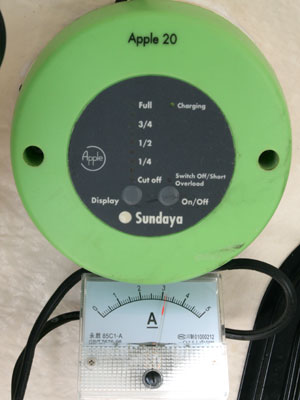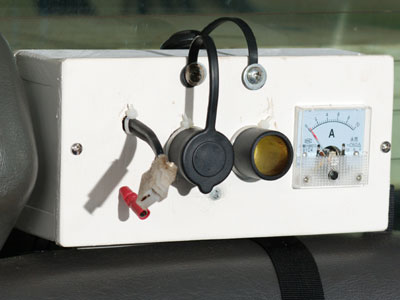Battery power can be stressful. How much capacity is being used? How much is remaining? How much is being recharged? Installing cheap panel ammeters have greatly improved my understanding of my auxiliary (‘aux’) battery system.

Basic solar charge controller upgraded with a DC ammeter. This is from my old system (3 A solar panel, 5 A meter).
Battery monitoring
Voltage is a poor indication of battery capacity in working solar power systems where voltage varies with charging and loads. The battery would need to be rested before measuring voltage for estimating state of charge. Then voltage should be corrected for temperature.
It is more informative to measure the current going in to the battery and the current going out. If the solar charging current is higher than the average load, the battery will be storing the difference. If the average load is higher, the battery is supplying the difference.
If I am running out of battery capacity, I can use the ammeters to guide me in taking corrective action. The input ammeter can be used to improve solar panel positioning and to estimate daily charging input. The output ammeter can be used to decide which loads to disconnect or reduce.
Current measurement
I use analog DC panel ammeters because they are simple, do not consume power and are cheap (you can find them on ebay). Low-current ammeters (less than about 50 A) do not require an external ‘shunt resistor’ and are very easy to install (in series). I once tried cheap digital ammeters, with no instructions, and burnt both of them.
Ammeters can be installed on the positive cable (or negative if you prefer) and on both the input and output sides of the aux battery. The ammeters I have are marked with a ‘bar’ symbol at the negative or ‘downstream’ terminal. If the needle moves in the wrong direction, then swap the connections.
I recently built a custom power distribution panel using recycled connectors and plugs. You can buy DC power outlets and some have features like USB charging and maybe a voltmeter – just add an ammeter in series.

Custom power distribution panel with DC ammeter (10 A, which should cover any loads I plan to plug in). It’s made from timber and plywood and easily modified should I need to add more outlets. A voltmeter would be useful, but I already have one in my new charge controller.
Save money
Real battery monitors have microprocessors and can estimate remaining battery capacity at variable discharge rates via Peukert’s equation. Battery monitors are expensive gadgets. A simple volts and amps monitoring system is cheap and simple.
I now have an expensive and unnecessary Morningstar Prostar 30-M solar charge controller, which measures voltage and current. However, Morningstar do not recommend (see Tech Notes) to connect inverters and compressor fridge/freezers to the load terminals (installing a ‘clamping diode’ is a possible workaround). It is cheaper to buy a good basic solar charge controller, separate ammeters to monitor the charge and load currents and perhaps a voltmeter for precise battery voltage.
It depends on someone’s needs whether they should buy a real battery monitor or that a simple volts/amps meter will do the job. However, this could be a good alternative in most cases.